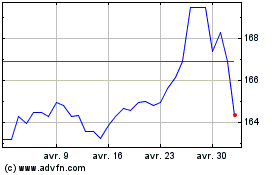Euro Rises Amid Higher European Stocks
05 Avril 2018 - 10:06AM
RTTF2
The euro advanced against its most major counterparts in the
European session on Thursday, in tandem with rising German bond
yields, and on improved risk sentiment amid easing trade war fears
between the U.S. and China.
Optimism about potential negotiations between the U.S. and China
to withdraw from their tariff plans reduced fears over trade
spat.
Trump's top economic adviser Larry Kudlow defended the
administration's proposed tariffs on Chinese goods, saying such an
approach could be a tactic to get China to negotiate on trade
practices.
The benchmark yield on German 10-year bunds rose 0.5 percent.
Yields move inversely to bond prices.
Final data from IHS Markit showed that Eurozone private sector
activity expanded at the weakest pace since the start of 2017 as
rates of growth moderated in both manufacturing and services.
The composite output index fell to 55.2 in March from 57.1 in
February. The score was also below the flash estimate of 55.3.
Data from Eurostat showed that Eurozone retail sales increased
at a slower-than-expected pace in February after falling in the
previous two months.
The volume of retail sales edged up 0.1 percent month-over-month
in February, reversing January's 0.3 percent drop, which was
revised from a 0.1 percent fall reported earlier.
Figures from Destatis showed that Germany's factory orders
recovered in February but the pace of expansion was much weaker
than expected.
Factory orders rose 0.3 percent month-on-month in February,
reversing a revised 3.5 percent decrease seen in January.
Economists had forecast a 1.5 percent rise.
The single currency bounced off to 1.2284 against the greenback,
from more than a 2-week low of 1.2249 hit at 3:00 am ET. The next
possible resistance for the euro is seen around the 1.25 level.
Reversing from an early low of 0.8716 against the pound, the
euro edged up to 0.8738. The euro is seen finding resistance around
the 0.90 region.
Survey data from IHS Markit showed that the UK service sector
expanded at the weakest pace since July 2016 due to bad
weather.
The IHS Markit/Chartered Institute of Procurement & Supply
Purchasing Managers' Index fell more-than-expected to 51.7 in March
from 54.5 in February. The score was forecast to drop to 54.0.
The euro hit a weekly high of 131.48 against the yen, compared
to Wednesday's closing value of 131.10. On the upside, 132.5 is
seen as the next resistance level for the euro.
The 19-nation currency recovered to 1.6873 against the kiwi,
1.5991 against the aussie and 1.5697 against the loonie, from its
early 1-1/2-month low of 1.6780, 2-week low of 1.5899 and a
multi-week low of 1.5641, respectively. The euro is likely to find
resistance around 1.70 against the kiwi, 1.62 against the aussie
and 1.59 against the loonie.
On the flip side, the euro pulled back to 1.1786 against the
franc, from an early 2-1/2-month high of 1.1805. On the downside,
1.15 is seen as the next support level for the euro.
Looking ahead, Canadian and U.S. trade data for February and
U.S. weekly jobless claims for the week ended March 31 are
scheduled for release in the New York session.
Euro vs Yen (FX:EURJPY)
Graphique Historique de la Devise
De Mar 2024 à Avr 2024

Euro vs Yen (FX:EURJPY)
Graphique Historique de la Devise
De Avr 2023 à Avr 2024
